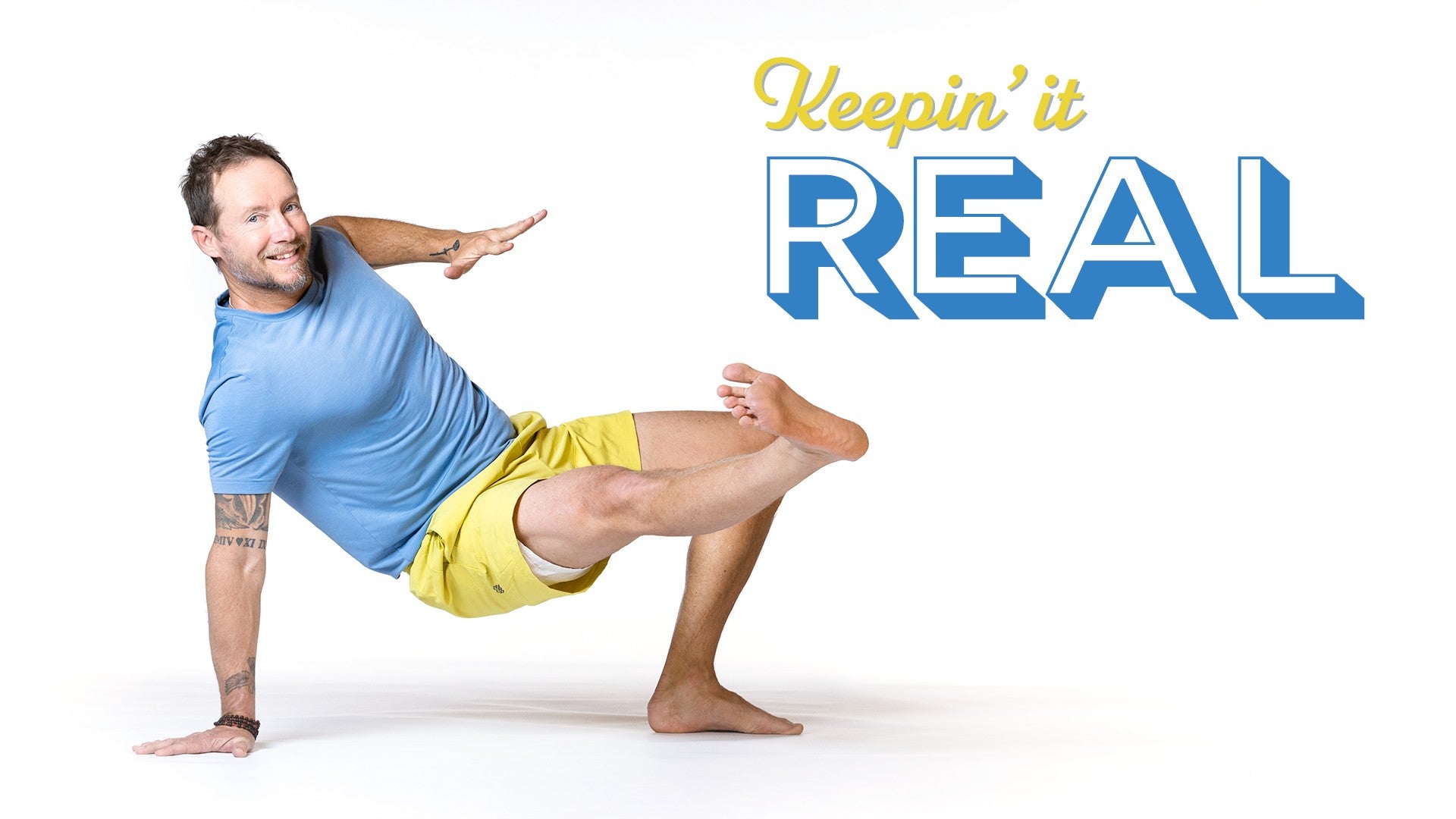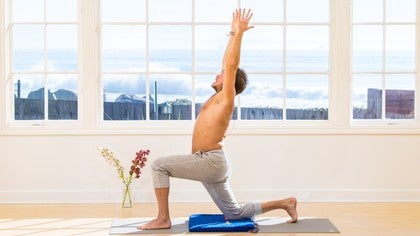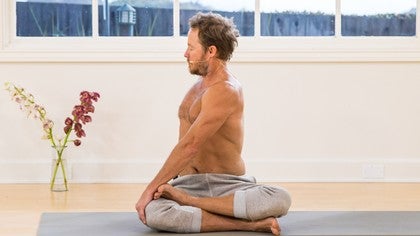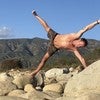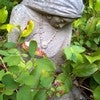Description
About This Video
Transcript
Read Full Transcript
(water splashing) Hey there how you doing, welcome back. My name is Robert, it's really good to see you again. This practice here is designed ideally, the way I really like it, right, personally, is first thing in the morning. Wake up, move your body, breathe, maybe even a little meditation in there, okay? But with that said, if this is the middle of day for you, evening, go for it, it can be done any time.
I just find it a beneficial way to start your day, alright. So, thanks for joining me, find your mat, lie down on your back, that's how we'll start, okay. (sighs) So for starters, make yourself comfortable. Make yourself fully comfortable, whatever you need to do, do it. Let your arms rest by your side.
Actually, let's do this, take a full body stretch, right. Reach your arms up over head, reach through your fingertips, your toes. (breathes) Take a huge breath in, and let a nice long exhale release from the body. (exhales) And then start to bring your hands, or your arms along side your body, maybe move them away from the body about six to 10 inches. Lift the head, lengthen the back of the neck. We'll take a few moments here to kinda like settle in right.
Settle in to your breath. So the idea here, and the way I like to express this, right, is just begin to pay attention. Begin to watch your breath, begin to notice. Be kinda like that witness, right, that silent witness. And it might feel nice for you to approach this type of practice as a real opportunity, not necessarily an obligation, or something you have to do.
An opportunity to genuinely like feel your body, and feel your breath. So, place your hands up on your stomach, and I'll cue you through some simple breath cues, right so we use our belly first. So, first meaning the breath originates in the stomach, so on your inhale through the nose, let the stomach rise a little bit. So kind of like inflate the stomach. And on the exhale let it deflate or gently contract.
(breathes) So belly rises on the inhalation, and falls on the exhalation. (breathes) Okay, keep rolling with that. (breathes) So the meditation aspect is, in this case, you paying attention, paying attention to what is, right now, without any sense of judgement or expectations. Watch your breath, feel your body. (breathes) Begin to feel the breath grow a little deeper possibly. Right, without forcing too much but, breathe in, stomach rises, and maybe even feel it build in the rib cage, and maybe even up toward the chest a little bit.
So, you can almost think of it us three parts, inhalation, stomach, continue the growth, right or the expansion through the rib cage, number two. And up in to the chest, number three, something like that, possibly. And here's another thing, right, if none of this is working for you, just let the breath flow in and flow out, alright. So you've got those options. Now take your right knee in towards your chest.
(clears throat) Hold on to either the hamstring, or the shin below the knee. I prefer the shin, right below the knee. And you're always checking in with the back of the neck, make sure the neck is long. And then pull the knee in toward the body, and now feel free to move that knee around a little bit, begin to feel for like, without over thinking it, how can this posture serve you right now, how is it useful? So continuing your breath awareness, right.
And when I say breath awareness, it's just watching. Watching it. And when the thoughts of the day, the beginning of the day, the end of the day start to roll in. So be it, watch them as well. Try not to hang on to any one thought.
Alright so from here, after you've explored, right, you've got full license to explore in these postures. You may even take that right hand, release the left, and open the hip a little bit. Alright, little circles. Then place the right ankle, as you bend your left leg, put the left foot on the mat, place the right ankle on top of the left thigh. Now this is a real, for you maybe it's a huge feeling, for me it's pretty subtle but it feels nice.
If I press my right hand on my thigh, and push that hip open, like gently guide that hip away from where the knee opens. Alright that might feel nice. So that's the first part of recline pigeon. The next part would be for you to lift your left foot up, maybe even use your core muscles first to get the movement, to deepen, right, to deepen the stretch. Which you may be feeling through the right hip, your IT band, your glutes.
Okay now find an appropriate hand position, I like to hold on all the way up to the shin, below the knee, you might wanna hold on to the hamstring. So wiggle your way around in to that hand hold, right. And so another cue would be for you to point your right toes straight up, right really engaging the musculature up through the right shin and all the way up into the knee, this'll help protect your knee, alright. So, right around here is where I begin to feel, like, the intensity. So what I'm going to do, and what I feel is really helpful, is I breathe in (breathes) and with a nice long exhalation (breathes) I simultaneously kind of pull into that intensity, deepening the stretch, alright.
So the exhale, that long extended exhale, is helping to possibly create a little opening, a little space there. And what you can do is you can kinda cycle in and out a couple times. So if you breathe in, move away from that intensity (breathes) and exhale, pull back into it. (breathes) And again any kind of like rocking side to side, any kind of movement, alright what we wanna do right now in this sequence is move, move your body and breathe. Alright, now release that, bring your left foot down, and with your left foot press into the mat, and kinda shift your hips over to the right. Right, so you're almost on your left hip.
Take your arms out, and we'll take a casual spinal twist. Alright, so let that right knee draw across your body to the left. And when I cue you to bring your arms open, try palms up, that might feel more spacious across the chest, shoulders, biceps, forearms. Alright, so again, maybe it feels good for you to kinda back out a little bit on the breath in. And on the breath out (breathes) twist.
And hopefully, maybe, you might feel little release in your low back, your mid-back, open the chest, okay. After you've kind of done that a couple times, and you've had your fun there, come back out. Situate yourself back to center. Release the right foot. Let's take another big stretch, right.
So both legs out, reach up back behind you. (breathes) Again, opportunity, think about this right, think about this as your intention or reason for doing this, right it is simply to find pleasure in the experience. The opportunity to be able to stretch. To be able to breathe, and kind of weave those two things together, right, breath and body awareness. Okay, now you've taken that big body stretch, now hug the left knee in.
Find your hold, right, this isn't right, this isn't right, there's nothing really right or wrong. If you're in severe pain and you're hurting yourself, that might be a little wrong, so mindful of that. So one cue I didn't give to you on the other side was, if in this position, you might even see, I've got a little bit of an arch in my back. And my back feels fine, but if you feel any kind of like, unnecessary tension or pinching there, you may find some more comfort by bending this right leg and grounding that foot. And you may have just noticed my back kinda set a little bit, try that.
And also you may notice that I keep extending my neck long, if not it ends up kinda doing this kind of thing, alright, I wanna stay away from that. Okay, so knee to chest, also known as wind relieving posture. So, feel free to let it flow. (laughs) And if you're in your house, alone, go for it. Wind relieving pose. Alright left ankle on top of the right thigh, guide that hip open, alright.
So when I do this I feel this nice little release in my inner left groin region, right, hip groin. And it feels nice, it's subtle, but it's nice. Alright so the hip is open, I'm still breathing, I'm still feeling, I'm still watching, right. Now I'm gonna go a little deeper, right, it's a different stretch, I don't feel it in my glute, or my IT band, right, that traditional pigeon pose. But now, I bring it up, I flex the toes upward, I find the hold that feels appropriate.
I take a breath in. And a nice long extended breath out. (breathes) Then I rock side to side a little bit. There's a sense of curiosity that can be brought into the practice. Exploration, curiosity, like it's interesting, like hmm, if I move over here how does that feel? Any opportunity to roll the ankles.
So go ahead an exit there. If any of these poses you wanna stay and stew longer, feel free. Okay now the right foot comes down, shift the hips over, this'll help kind of align the spine for the twist. And then when you do that, check in with the upper back, like spread the upper back, get a nice grounded sense of the upper back. You can feel free to extend that right leg.
You can even cross this leg over farther, further. And twist. (breathes) So I'm gonna come back out, shift over even farther. What is it farther or further? Doesn't matter, I think you understand, so twisting and, for me just to give you a little insight, is my back, my low back, into my low left waist, is where I feel this like nice stretch or release. Slowly come back out.
Shift back over to center. This time go ahead and hug both knees into the chest. One way that I find is really nice is if I wrap my arms behind the hamstrings, holding on to either my fingers, a wrist, or some of you may even hold on to opposite elbows. Now this gives me the balance to be able to now massage the low back. Okay.
Again, one of the reasons I'm offering this sequence is because first thing in the morning, right, the body's tight, the body wants to be moved. And so it's an opportunity for me to kinda like massage, self-care, move the body, before I start my day. Okay, so now, bring the feet down. And roll to your right side. Roll on to your right side, keeping your knees bent.
And then rest your head on your right arm, take a moment here. Take like three full breaths, so you take a full breath in. And let a nice long extended breath out. (breaths) Do that two more times. (breathes) One more time, breathe in. And breathe out. (breathes) From here push yourself up.
Alright, so if you have a blanket, a towel, some kind of cushion even, something that kind of props yourself up, grab it. I've got this little blanket here, a yoga blanket. I've got it folded up with this height, alright so you can go this height, you can go a little bit less, or you can even go a little higher. So you'll see, maybe that if I'm seated, I'll do an exaggerated version, alright. So a lot of the times we'll sit like this, and the knees come up.
And this is supposedly an easy comfortable seat, right? So, what we're gonna do is prop our seat up on the edge of it. And that might look a little bit different, alright. So from here, really just find a comfortable seated posture. We're gonna be here for a few moments.
So (breathes) hello. When I'm on my back I don't get to really engage with you, so hopefully you're looking right at me and we can say what's up, hi, how are you? And now we'll continue on, right. So, so far I've been talking about the breath. Just simply watching the breath, feeling the breath.
And then whatever sensations or feelings each and every pose brings up. Just kinda notice that, right. So keep it simple. And again it's the opportunity, right. Opportunity, not an obligation or something you've got to do, okay.
So, seated twist. So take your right hand over to the left knee. Left hand back behind you. And the tendency I think is to get a little rounded here, so lift the chest, try to get a little lengthened and long, right, breath in, and then go ahead and twist to your kind of moderate degree. So when you find that resistance, right.
Right around there. And maybe if your neck allows, and it feels okay, look over the left shoulder. For me, I've got an insane beautiful view today. There's huge surf, so I'll hang out here for another breath. Okay, slowly come out.
So the way I like to come out is I take my head first, and then release the hold, and then let the spine kind of undo, right. Breathe in, breathe out, twist over to the right side. So again, no rounding here, get as long as you can. Long and extended in the spine, lift up open the chest, and twist, something like this, right? Your version.
But think about it, right, your spine is mean to rotate and move, so it's essential that you do this. And, if I'm in the United States, I'm driving right? And I need to go in reverse, this is a super useful posture to be, or to have that kind of mobility, right? So if you're like in the UK or another country, the other way is for you, alright? So again twist, look over the shoulder, take in whatever view you've got, if your view is minimal and you just have a wall, and it's all this clutter, maybe close your eyes, and have a few moments to visualize whatever you wanna visualize.
Breathe in, breathe out, good slowly come back over to center. Take your arms up overhead with a breath in. And breathe out, fold forward. (breathes) So I have the availability in my body to fold forward quite a bit, you might land right around here, right? Or even you can't go forward at all, your knees are up here, so find your version, right, I'll give this version, we'll stay a couple breaths. And if you're all the way down, maybe there's a little side stretch you can access.
There's where that curiosity, that exploration comes in play, right. And if you're up here, maybe you're just here, and that's enough. Breathe in, breathe out, alright. Find that sense of contentment, right, you might be feeling discomfort in your knee, you've got some knee injury right you've been dealing with for yours (breathes) it is what it is, breathe in, breathe out, let it go. Alright, okay.
So here we folded forward, now another one that might feel nice is if you bring your hands back behind you, right. I'm tenting my fingerprints, kind of like this behind me. You can bring your palms down, or even place them on the blanket. But find that space first, so take the chest, open it up, reach back, maybe turn, see how my shoulders are forward here, I wanna roll the shoulder heads back. And now I've got a really nice opportunity here to take a few breaths where I'm stretching and opening the front of my body.
If you sit at a desk, you drive for any period of time, it might feel good, just this, right. It's a simple posture, but I say simple, but for you it might not be, so I respect that. But open up, if you have the availability in the neck, left the chin, push the chest forward. If this bothers your back, leave it out, come to a neutral position. (breathes) Alright cool, bring yourself back up to a neutral position. Hands on the knees, let's rotate or move the spine into a flexed position an extended position in a seated cat cow.
So we'll first start by, very similar to what we just did, hands on the knees, chest up, breathe in. (breathes) And breathe out, chin draws to the chest. Getting to kinda pull and almost like concave the front of your body and round out your back. This is the flexion version, right, another way the spine is designed to move. Breathe in (breathes) and breathe out. (breathes) One more time breathe in (breathes) and breathe out. (breathes) Inhale back into a neutral position, take your right hand out, take the left arm reach it up and get a little side bend. So you can take your left arm way up high, right, if that feels good.
I feel, for me, if I place my hand behind my head and push my head into my hand, then pull the elbow up. Or pull it back, and then lead with the elbow up and over. What I'm searching for really is this side stretch, okay. So either the hand here or up high, you choose. Keep moving the right hand around, find out where that placement can be more ideal for you. (breathes) Remember to keep following the breath.
Okay come back up. And when you do this, right, try to get some like equal length. Don't just (grunts) right. Equal length up into both sides of the body to come over. So.
Lengthen. And so this is again, right, I'm kind of harping on the ways the spine likes to move, right, lateral flexion, this is another way it's meant to move so we wanna move it. Maybe it's nice also to kinda like close your eyes as you come in to some of these poses. (breathes) Minimize some of the visual distractions in your home or office or wherever you're doing this. Okay, cool, come back up.
Bring the arms down, one last little thing here with the seated posture. And feel free to shift up the legs, right. So if your knees get sore, take the legs out. Shake 'em out, redo, okay. So, and I'll just reiterate.
Like I've done this in a certain way, right, we've been doing these poses, I encourage you to follow it, but also like as you begin to like become more and more comfortable you'll see how you can adjust and change it, to make it your own, right. That's really what we're trying to do here, is create these sequences, so that you can develop your own, kind of home practice eventually, okay. So, change your legs, interlace your fingers, press your palms forward and then bring those palms up toward the ceiling. Notice any kind of resistance in your shoulders, maybe even take a side bend again. Think about also when you breathe in, that inhalation is lengthening, is lifting its space, right.
So breathe in, stay lifted, exhale. (breathes) Good knuckles forward and now chin to the chest, and get that little, it was like we did for cat pose right? Chin to the chest and push the knuckles forward and spread your back out as much as you can. Good, very nice. Back up, one more time, big breath in. (breathes) And exhale, the arms down by your side. (breathes) Okay, and you know, we're not gonna spend much time on it but any kind of neck movement that feels good for you, you know stretch out the neck. Okay, now on to hands and knees for child's pose.
So anyway you wanna get there. If you've got the blanket, move it out of the way, unless you find it useful for anything coming up, right. Hands and knees, take your knees about as wide as the mat. Okay, so about as wide as the mat. But if that's too much, minimize it.
Un-tuck the toes, and bring your seat back towards you heels. And it may be an exhale that you do that on. So breathe in (breathes) and exhale. (exhales) Do that again breathe in come out of it, (breathes) breathe out. (exhales) Now, I've seen child's pose look many different ways. This is how I'll land in it, right. This feels good for me.
I've also seen child's pose look like this, right. So if you've got any kind of like props around you, you put a big blanket or pillow in between your hamstrings and calves, you feel free to tuck your toes. If your head is this far up off the mat, you can find some kind of way to stack your fists or get a pillow, make it as comfortable as you possibly can. Okay so now, child's pose. Your way, five breaths, breathe in (breathes), breathe out (exhales) and if my knees are a little more narrow, one of my favorite versions is if I bring my hands back, underneath, kinda like my wrists reaching back toward my heels, right.
I can even interlace my fingers. (breathes) What this does is its minimal muscular effort in the shoulders, right? In the yoga practice the shoulders take a lotta heat, right. So now it's nice to just relax them completely. Okay, so you're probably done with those five breaths. Stay here for as long as you'd like, and catch up or stretch the arms forward.
Breathe in, pause and breathe out, (breathes) so now it's hands and knees version of cat cow okay. Start off lazy belly, like the laziest laziest belly ever, okay so here when I do that, there's this little arching of the back, right. So my butt kinda naturally lifts up, okay. Okay now exaggerate it even more by pulling the elbows in the direction of your thighs and then reaching your chest forward. Now, you may feel like to, you know to do the pose right, you have to do this, right?
So maybe practice just finding whatever range in the neck feels appropriate for the cow posture, right. For me, right around here feels nice. Again, lazy belly, arched back. (breathes) Now do the opposite, on the exhale, begin to draw the chin to the chest, and then watch here, I'm gonna initially move my tailbone back and down, right, so there's this pelvic movement. Which then initiates the movement in the belly. And I pull the belly up and in, and round the upper back, full exhalation, like you're trying to carve so much space out of the front of the body, right.
Exhale, exhale, exhale, exhale, exhale. And now inhale. (breathes) Exhale. (breathes) Do a few more rounds, if this is bothering your wrist, take a moment, turn the wrist over, one at a time or two at a time. Maybe lean back a little bit, get that opposing wrist stretch, okay? Couple more, breathing in, cow pose, breathing out, cat pose. You can also kind of come on to your fingertips.
This kinda adds another sensation. Okay, again so, remember about what I said in the seated version of this. This is the extension, right, this is extension for your spine, and now we've got flexion. Two ways meant to move. You're doing your spine a great service by doing this.
So take one more round. (breathes) Super. Awesome. Alright, so now we've done that, now curl the toes, downward facing dog, alright. So I'm gonna cue you the best I possibly can, for your most successful down down dog. Toes are curled, gonna lift my knees, right.
I'm gonna make sure my hands are spread wide, fingers are spread wide, I've got a good connection, my hands and my feet. Then watch how I kinda like reach my chest toward my thighs, right, immediately I've got a little bit more of this, you can see my spine kinda lengthening as opposed to this rounding kind of quality that happens a lot. So here, here, and then I begin to kinda like straighten one leg, straighten the other. I can still kinda find some more options here, right, so what I see a lot is is this, right. So if you're that person, do yourself a great service, right.
Come in to a plank pose, push up position, keep that position with that hands and the feet, soften the knees a little bit, reach back, and now reach up, reach the butt up meaning right. So you see how my knees are bent, this allows me to stay long and extended in my spine as opposed to rounded and just shoulder burning, right. Once I get this little like knee bent, long spine, downward dog, I don't feel it in my shoulders much, right. My arms are supporting me. Then, from here what I can do, is I can kinda press one leg straight, then the other, maybe send my hips to one way.
Send it to the other. So if you're new, right, this is gonna be overwhelming. Stay with it. And if you're a practiced downward dogger, feel free to roam. Roam and let this pose really serve a purpose for you, like where is it opening, where is stretching?
And how can I make it more interesting? Or keep it simple, it doesn't have to be that interesting. Alright so from downward dog, maybe you know, you wanna rest. Go through another cat cow. (breathes) Feel free to come back up for another downward dog, or explore this side plank variation. So from here, it's important, it's a good lesson also in like how to stack for different poses.
So I'm gonna come on to my right arm. My hand is below my right shoulder, okay. Now extend my left leg back. And my right knee is below the hip. Okay, got that so far?
Now here for balance purposes, my right foot, I'm gonna kinda slide it over to the right. Then, as opposed to just lifting my arm up. I'm gonna actually slide the fingertips up the right forearm, my bicep, shoulder, chest. So you might see a difference rather than just this than this. And so here, you can practice just sort of stabilizing yourself.
Another key would be to do this and instead of having that reaching out, pull the shoulder back in, right, you'll see it on the other side, when I do the other side. Then the arm comes up and you're a little more stable and connected through the upper back, right. Now explore what this might feel like. Stretching, right, and opening the rib cage, intercostals. Feel free to kind of move through the shoulder a little bit.
(breathes) Keep breathing in. And breathing out. (breathes) You can also lift that leg, right, you can get super creative and bend and open the chest and all of that jazz, but for now, keep it simple. Hand down, tabletop, maybe take a little cat cow, right? Little clearing. (breathes heavily) Okay, the other side. So, left foot over, little kickstand, right leg out.
Left hand right below the shoulder, notice how I even take it a little farther forward because sometimes right under there's this like little pinch that happens with my shoulder. So if it's a little farther forward, it feels good. And again, spread the fingers, foundation right? So here, one more time, slide it up. (breathes) Free up the neck. So you'll see here sometimes I see a lot of people come into this posture this side plank and there's no real connecting going on in the back, this part of your back, the shoulder blade region, right?
So what I want you to do is kinda pull, rounded out on the upper back, shoulder blade disconnected. Now connect it, then up, and you may be able to see a difference. (breathes) Stretch. Again, right, curious. Starting your day. Positive internal dialogue.
(breathes) Bring it on down. Good, tabletop. One last little thing, before we kinda close out, right? So, child's pose. Reach the hands forward.
So stay with me here, breathe in to tabletop. (breathes) And then breathe out, it's like a reverse upward dog into cobra down to the mat. So it's breathing in into table. And then see how my arms are straight, I let my hips come forward. Be mindful of your low back, this may not work for you. Right, but once I'm here I even get a little like, lazy in the shoulders but then bend the arms, and kinda pull yourself forward and down. (breathes) I come up through cobra, I get a little more engaged in my arms, see how they're kind of pulled into my side body, right?
Here, and then I pull from my bell, my core, and pull all the way back through table and child's. So I'll do a couple without many cues. I'll just give you the breath cues. So breathing in. (breathes) Breathing out. (breathes) Breathing in. (breathes) Breathing out. (breathes) One more time, breathe in. (breathes) And breathe out. (breathes) Breathe in. (breathe) And. (exhales) Good, pause here for a few breaths. (breathes) Let all muscular effort go. (breathes) And so from here you have the option.
You have the option to stay in child's pose. Or come up into a kneeling position. Or even lie on your back for a final relaxation. You can take final relaxation in child's pose, you can take it here. You can take it on your back, it doesn't matter but do take, you know, two to five minutes, if you have the time, right.
To lie down, be quiet, silent, before you start your day. Or end your day. So, that's the sequence, right. So like I said before, I personally find it very beneficial. For my older 45 year old body.
But it's not even about the physicality as much, it's like it's starting my day, super conscious, right. I'm feeling my body, my breath. I begin to kinda like create a positive dialogue, alright. There's a positive dialogue, internal dialogue, that I create for myself, some sort of manifestation for my day, like I'm gonna kick ass today. Alright, I'm gonna be a badass, or whatever it is for you, right.
The negative stuff is way too easy. So, work at shifting to the positive. But anyway that's enough for now, I really appreciate you joining me, I hope you have a fantastic day, or sleep, or wherever you are after this. So thank you, and I'll see you next time you join me. Namaste.
Keepin' it Real
Comments
You need to be a subscriber to post a comment.
Please Log In or Create an Account to start your free trial.
